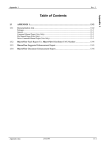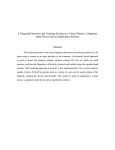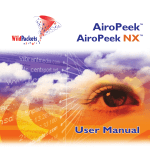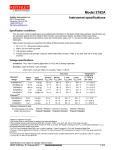Download Part 5
Transcript
CSE 5324: Software Engineering I
(Analysis, Design, Creation)
Review
Preview
Brooks Book Chapter
New stuff
What is important
What is next...
Last class(es):
Software Engineering is...
Introduction, Terms, concepts, etc.
Process: what is, life cycles
Requirements....
Class Song
(or school song)
Requirements
What are good requirements?
How do you do requirements and specification?
Requirements:
Architecture templates (ACD, AFD)
User Interface
Input
Process
Maintenance, Self-test
Output
Requirement - feature of the system
Elicitation - capture the users needs,
categorize: must be met, desirable, (etc.)
Definition vs. Specification
Functional vs. non-functional requirements
Structured Analysis:
Based on ideas of structured programming
(when programming was most important)
Source to Sink:
Input to output
Flows
Transform
Data Flow Diagrams
Data Dictionaries
(Other ways might be OO, for example)
Requirements
What are good requirements?
How do you do requirements and specification?
Team projects
Group "Job" application
Introduction and some review:
Team projects:
This is what SE is about
Projects:
Build a SE "tool" (An OO web based tool)
A virtual map of UTA where current classrooms
are determined and displayed (VRML or similar)
Simulation: Computer architecture, OS, Network
(web)
External customer (volunteer service groups, CSE, the library)
(May allow others)
Objected Oriented Software Engineering:
Is this (OO) really so different?
Review:
Requirements (can be):
Text
Structured (SA)
Formal Methods
Object Oriented
Many more
What is good, what’s bad (about each)?
Objects:
(Should) model the “real” world
Assumes an evolutionary process model
Tend to evolve; allow re-use
O-O is analysis, design, and programming
An object may represent real world entities
A Class is an abstraction of objects
You do this now: Pascal and C:
Types, records, structures.
May build upon other types, records and structs.
Objected Oriented Software Engineering:
OOA – Analysis
What is analysis: specify and model a problem.
OOA:
What are the objects?
How do they interact?
How do objects act (behave) in the system?
How to specify or model a problem with objects to
Create a design?
Objects are closer to the way we really think about
problems. We categorize, classify, make
relationships, actions are on objects.
Brooks: manipulate the essence, rather than the
mapping into an implementation accident.
The benefits are “up-front”. Conceptual issues
rather than implementation have benefit for
later phases. Don’t need to use OO programming
to get benefit of OOA (or OOD).
All OO includes:
“Identity” (Objects)
Classification (Objects with same attributes and
Operations are grouped into a class)
Polymorphism (same operation behaves
different on different classes)
Inheritance (sharing of attributes and operations
Based on hierarchical relationship)
Object Modeling Technique (OMT)
(Rumbaugh, etc)
1. Analysis: (what)
2. System Design ( overall architecture – subsystems)
3. Object Design ( Implementation details of objects)
4. Implement (minor and mechanical)
Three “models” to describe a system:
1. Object Model (static structure)
2. Dynamic Model ( Control – how system changes over time, state
diagrams, transitions, events)
3. Functional Model ( DFD’s )
This is different from function oriented methodology:
FO specifies and decomposes system functions.
OO identifies application domain objects, fits
Procedures around them.
Some themes:
Abstraction (essential aspects, not accidental)
Encapsulation (information hiding – separate
external accessible aspects from internal
implementation. )
Combine data and behavior ( data hierarchy and
Procedure hierarchy are combined)
Sharing (inheritance)
Emphasis on Objects not procedures (what
Object is, not how used)
OOA Methods:
Booch:
Micro and macro development
Micro is re-applied to each macro step.
Coad and Yourdon:
Simple. Like SA and other Yourdon
Methodology. “What to look for”
Then top-down. General to specific,
Whole to part.
Rumbaugh
OMT (above)
Unified Method (UML)
Booch and Rumbaugh
Wirfs-Brock
Analsys and design combined.
Tools to extract classes from specification.
Identify super classes. More bottom-up.
UML:
"Unified" Modeling Language
Model to simplify reality
Visualize a system
Specify structure and behavior
Template to help construct system
Helps document system
The choice of a model has profound influence on how
system is analyzed and solution built
May specify at increasing levels of "precision" (detail)
Best models are connected to reality
No single model is sufficient
UML:
Classes
Window
Class Name
Origin
Size
Attributes
open( )
close( )
move( )
show( )
Operations (methods)
UML:
Shape
Position
move( )
display( )
Generalization (Single inheritance)
Box
Circle
Corner
Radius
UML:
University
Department
1
has
1..*
1..*
1..*
member
*
Student
1..*
*
attends
* Course
Structural Relationships
aggregation
University has 1 or more students
Each student may attend many courses;
each course may have many students
University has one or more departments
(University is a "whole" student and departments are
its parts)
UML:
Structural "things":
Classes (and class interfaces, collaborators - what classes are needed,
use case - sequence of actions yielding observable result;
use case from "actors")
Also has:
Behavioral
Interactions - messages between objects
State machines - sequence of states in response to events
(And some others - like "groupings" and runtimes, etc.)
Reuse and domain analysis
Common requirements for specific application
Domain
Use class libraries:
Faster, less cost, fewer defects
Examples:
MicroSoft, Graphics, Database
Berard:
What is the domain?
Categorize Items
Collect representative sample of applications
Analyze each application
Develop analysis model for objects
Use Case:
Scenario of how system will be used.
Actors – people (or machines, or other software) that
Represent roles (not a user – who is typically
different actors at different times.)
Jacobson:
What preformed by actor?
What will actor acquire, produce, modify?
What does actor want from system?
Firesmith
Taxonomy of class types:
Device classes
Interaction classes
Tangible? (real or abstact)
Inclusive?
Sequential (or concurrent control - access)
Persistent (transient, permanent)
Wirfs
Evenly distributed intelligence
Generalized responsibility
Encapsulate
Localize information in a class
Object Relationships
Verbs – location, placement (part of, next to)
Ownership – made up of
Manages, controls, etc.
What is good:
Reality
Success on many projects
Reuse
Tools
What is bad?
Difficult to get used to
Can user understand
Can you?
A quick review:
General introduction to software engineering
What is Software Engineering? Gave several definitions.
Differences between Programming and Software Engineering
Why is software engineering important?
What are the Software Engineering Goals?
PROCESS
Process, methods, tools, (KPA)
What is software engineering?
Maintenance
Process
CMM SEI
Process models
Code and Fix,
Waterfall,
prototyping, RAD,
incremental,
spiral,
component assembly,
formal methods
Software Life Cycle
Concepts of Software life cycle versus Project Life Cycle
PRINCIPLES OF ANALYSIS AND ANALYSIS MODELING
Requirements
models, prototype,
specification and review
REQUIREMENTS
Structured, Formal Methods, Cleanroom
Requirements Analysis - General
Focus and Objectives
Determine WHAT is needed, not HOW it will work
specify software functionality
performance criteria
software interfaces with other systems
design constraints
Phase Products: SRS and Preliminary User's Manual
Benefits of requirements engineering
Requirements Engineering Process
Requirements Analysis
Definition: Requirements Elicitation
Domain Understanding
Requirements Collection
Classification
Conflict Resolution
Prioritization
Requirements Validation
Requirements Definition
Requirements Specification
What are good requirements?
Specification Principles
Characteristics of good requirements
Structured Analysis Method
Dataflow Diagrams (DFDs)
Notation
DEF : CONTEXT DIAGRAM
DEF : DATA FLOW DIAGRAM (DFD)
Hierarchy, concept of leveling and balancing
Guidelines for creating data flow diagrams
Data Dictionary (DD)
Information for primitive and group DD entries
Definition notation for a group
Process Specifications (Pspecs)
Definition: primitive process
Definition: PSPEC (Process Specification)
Pspec information:
PSPEC ID, Process Name, Input and Output flows,
Specification, Comments
Styles of Specification
Narrative English
Structured English
What I need to know:
Teams and projects
Requirements:
What are good?
How to do?
SA
OOA
Short answers:
Several software process models have been discussed, 3 are:
"linear sequential", "prototyping" and "incremental" models.
Give one similarity to all models.
Give one difference between each pair of models.
Similar:
Differences:
You go to work for a company that is CMM level 2 organization.
(a) List 3 KPA's that you should see.
The company is discussing trying to evolve to a level 4
organization, but has estimated that it will cost 2 million dollars
to do so, plus an additional 1 million dollars per year.
Currently there are 200 software engineers costing
(on average) $100 thousand each.
(b) Present an argument (for or against) that it is economically
worthwhile, and when (how soon) is the pay back.
(c) Why would a level 4 organization need to spend million
extra per year over a level 2?
3. [20 pts]
A bicycle "computer" is a device that allows a bicycle rider to calculate
a few interesting parameters during a trip. The bicycle computer (called "BiC")
has a simple 6 digit display, and additionally there are display indicators that
display the "mode" of the BiC. These mode indicators show what the BiC is
currently displaying (distance traveled or average speed).
To reset the time and distance counts there are buttons to:
clear (reset counts), set distance measuring mode, set average speed mode,
and turn BiC off.
A small computer provides control functions and has as a time base a
small clock that it can read (hours:minutes:seconds).
The revolution of the wheel may interrupt or be read by the BiC, signifying
a 1/3 of a meter traveled. (The wheel turns 3 times per meter)
(If you think that additional hardware is necessary who must explain why
and then describe in detail.)
a.) Show an ACD for Bic.
b.) What is the ACD used for, what is its purpose?
A cell telephone needs to store telephone numbers for "rapid dial" (ie
the user hits a rapid dial key, then N to dial the N'th phone number)
Only legal telephone numbers may be stored: local 7 digit phone numbers
(that do not begin with 1 or 0), special numbers (911, 411, and 0),
US long distance ("1" followed by a three digit area code - not starting with 0 followed by a 7 digit phone number, described above), or international numbers
( 011 followed by a country code of up to 3 digits, followed by a city code
of up to 4 digits, followed by a phone number of up to 9 digits; where the
country, city, and phone numbers may not begin with 0)
(a) Please show the data dictionary for legal phone numbers.
(b) Why is this data dictionary needed, where would it be used?
(c) In your software development group an argument starts, during
analysis, about whether to store the telephone numbers in long
binary format (fixed length) or as 4 bit digits (variable length,
to save space). You are the team leader, settle the argument. Explain.
6. [20 pts]
Your organization is given the job of developing a portable, electronic,
downloadable book. The book is a small display (40 lines of about 50
characters
each) in a plastic case with buttons at the bottom for: scrolling (up, down,
left, right), and a menu selector for allowing the user to "command" the book:
download a new book, go to a page number, etc.
At the top is a small infrared "port" that allows communication to a special
book provider who sends books to the device.
a.) If (or where) there are ambiguities or omissions, please describe them and
describe how you will deal with them.
b.) Show a context diagram (DFD) and as many levels of decomposition as
needed, to a maximum level of 2, for the book (Follow the standard for DFD).
You don't need to write PSpec or DD's.
c.) Please write a process specification (PSpec) that is invoked to handle
the scroll down. Use structured English for the specification,
follow standards for process specifications.
Bonus:
What does Brooks say about "the second system" effect? Explain.
Why does it cause problems?
Bonus:
You are shipwrecked on a deserted tropical island.
You may choose the one person with you.
That person is:
a.) A medical doctor with survival training
b.) An expert boat builder
c.) The instructor of this class
d.) Someone who looks good in a swimming suit
Review
Preview
Brooks Book Chapter
New stuff
What is important
What is next...
Last class(es):
Software Engineering is...
Introduction, Terms, concepts, etc.
Process: what is, life cycles
Requirements
Structured Analysis
Requirements
What are good requirements?
How do you do requirements and specification?
Team projects
Group "Job" application
Introduction and some review:
Team projects:
This is what SE is about
Projects:
Build a SE "tool" (An OO web based tool)
A virtual map of UTA where current classrooms
are determined and displayed (VRML or similar)
Simulation: Computer architecture, OS, Network
(web)
External customer (volunteer service groups, CSE, the library)
(May allow others)
Objected Oriented Software Engineering:
Is this (OO) really so different?
Review:
Requirements (can be):
Text
Structured (SA)
Formal Methods
Object Oriented
Many more
What is good, what’s bad (about each)?
Objects:
(Should) model the “real” world
Assumes an evolutionary process model
Tend to evolve; allow re-use
O-O is analysis, design, and programming
An object may represent real world entities
A Class is an abstraction of objects
You do this now: Pascal and C:
Types, records, structures.
May build upon other types, records and structs.
Objected Oriented Software Engineering:
OOA – Analysis
What is analysis: specify and model a problem.
OOA:
What are the objects?
How do they interact?
How do objects act (behave) in the system?
How to specify or model a problem with objects to
Create a design?
Objects are closer to the way we really think about
problems. We categorize, classify, make
relationships, actions are on objects.
Brooks: manipulate the essence, rather than the
mapping into an implementation accident.
The benefits are “up-front”. Conceptual issues
rather than implementation have benefit for
later phases. Don’t need to use OO programming
to get benefit of OOA (or OOD).
All OO includes:
“Identity” (Objects)
Classification (Objects with same attributes and
Operations are grouped into a class)
Polymorphism (same operation behaves
different on different classes)
Inheritance (sharing of attributes and operations
Based on hierarchical relationship)
Object Modeling Technique (OMT)
(Rumbaugh, etc)
5. Analysis: (what)
6. System Design ( overall architecture – subsystems)
7. Object Design ( Implementation details of objects)
8. Implement (minor and mechanical)
Three “models” to describe a system:
4. Object Model (static structure)
5. Dynamic Model ( Control – how system changes over time, state
diagrams, transitions, events)
6. Functional Model ( DFD’s )
This is different from function oriented methodology:
FO specifies and decomposes system functions.
OO identifies application domain objects, fits
Procedures around them.
Some themes:
Abstraction (essential aspects, not accidental)
Encapsulation (information hiding – separate
external accessible aspects from internal
implementation. )
Combine data and behavior ( data hierarchy and
Procedure hierarchy are combined)
Sharing (inheritance)
Emphasis on Objects not procedures (what
Object is, not how used)
OOA Methods:
Booch:
Micro and macro development
Micro is re-applied to each macro step.
Coad and Yourdon:
Simple. Like SA and other Yourdon
Methodology. “What to look for”
Then top-down. General to specific,
Whole to part.
Rumbaugh
OMT (above)
Unified Method (UML)
Booch and Rumbaugh
Wirfs-Brock
Analsys and design combined.
Tools to extract classes from specification.
Identify super classes. More bottom-up.
UML:
"Unified" Modeling Language
Model to simplify reality
Visualize a system
Specify structure and behavior
Template to help construct system
Helps document system
The choice of a model has profound influence on how
system is analyzed and solution built
May specify at increasing levels of "precision" (detail)
Best models are connected to reality
No single model is sufficient
UML:
Classes
Window
Class Name
Origin
Size
Attributes
open( )
close( )
move( )
show( )
Operations (methods)
UML:
Shape
Position
move( )
display( )
Generalization (Single inheritance)
Box
Circle
Corner
Radius
UML:
University
Department
1
has
1..*
1..*
1..*
member
*
Student
1..*
*
attends
* Course
Structural Relationships
aggregation
University has 1 or more students
Each student may attend many courses;
each course may have many students
University has one or more departments
(University is a "whole" student and departments are
its parts)
UML:
Structural "things":
Classes (and class interfaces, collaborators - what classes are needed,
use case - sequence of actions yielding observable result;
use case from "actors")
Also has:
Behavioral
Interactions - messages between objects
State machines - sequence of states in response to events
(And some others - like "groupings" and runtimes, etc.)
Reuse and domain analysis
Common requirements for specific application
Domain
Use class libraries:
Faster, less cost, fewer defects
Examples:
MicroSoft, Graphics, Database
Berard:
What is the domain?
Categorize Items
Collect representative sample of applications
Analyze each application
Develop analysis model for objects
Use Case:
Scenario of how system will be used.
Actors – people (or machines, or other software) that
Represent roles (not a user – who is typically
different actors at different times.)
Jacobson:
What preformed by actor?
What will actor acquire, produce, modify?
What does actor want from system?
Firesmith
Taxonomy of class types:
Device classes
Interaction classes
Tangible? (real or abstact)
Inclusive?
Sequential (or concurrent control - access)
Persistent (transient, permanent)
Wirfs
Evenly distributed intelligence
Generalized responsibility
Encapsulate
Localize information in a class
Object Relationships
Verbs – location, placement (part of, next to)
Ownership – made up of
Manages, controls, etc.
What is good:
Reality
Success on many projects
Reuse
Tools
What is bad?
Difficult to get used to
Can user understand
Can you?
Requirements
What are good requirements?
How do you do requirements and specification?
Structured Analysis (requirements and specification)
Object Oriented
What I need to know:
Teams and projects
Requirements:
What are good?
How to do?
SA
OOA
What's next:
Exam
then
More Requirements
Other ways to do...









































































